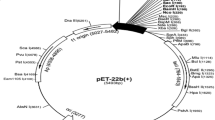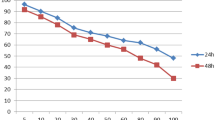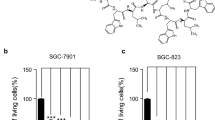Abstract
Cancer is one of the most causes of death all over the world, although improvements in its treatment and recognition. Due to the limitations of common anticancer methods, including surgery, chemotherapy, and radiotherapy, attention has been drawn to other anti-cancer compounds, especially natural peptides such as bacteriocins. In this study, we used a combination of two bacteriocins, colicin E1 and enterocin A, against AGS gastric cancer cell lines. In order to evaluate anticancer properties of fusion peptide, we applied MTT assay, real-time PCR, and flow cytometry tests. This is the first report to show the cell growth inhibitory activity of the enterocin A in combination with colicin E1 against AGS human cancer cells. The results of this study showed that this fusion peptide at a concentration of 60.4 µg/mL and 24 h was able to kill half of the tested cancer cells, and treatment of the cells with this concentration increased the expression of bax and caspase 3 genes and reduced the expression of bacl-2 in 24 h. Flow cytometry analysis of annexin V-FITC/propidium iodide results also showed that our peptide was able to induce apoptosis in treated cells compared with control. Taken together, enterocin A-colicin E1 (ent A-col E1) can be considered as a good candidate for anticancer therapies.




Similar content being viewed by others
Data Availability
All data analyzed during this study are included in this published article.
References
Jamali L, Tofigh R, Tutunchi S, Panahi G, Borhani F, Akhavan S, Nourmohammadi P, Ghaderian SMH, Rasouli M, Mirzaei H (2018) Circulating microRNAs as diagnostic and therapeutic biomarkers in gastric and esophageal cancers. J Cell Physiol 233(11):8538–8550. https://doi.org/10.1002/jcp.26850
Simonian M, Mosallayi M, Mirzaei H (2018) Circulating miR-21 as a novel biomarker in gastric cancer: diagnostic and prognostic biomarker. J Cancer Res Ther 14(2):475. https://doi.org/10.4103/0973-1482.175428
Faghihloo E, Araei Y, Mohammadi M, Mirzaei H, Mohammadi HR, Mokhtari-Azad T (2016) The effect of oxamflatin on the E-cadherin expression in the gastric cancer cell line. Cancer Gene Ther 23(11):396–399. https://doi.org/10.1038/cgt.2016.52
Jemal A, Bray F, Center MM, Ferlay J, Ward E, Forman D (2011) Global cancer statistics. CA Cancer J Clin 61(2):69–90. https://doi.org/10.3322/caac.21492
Li C, Tian ZN, Cai JP, Chen KX, Zhang B, Feng MY, Shi QT, Li R, Qin Y, Geng JS (2014) Panax ginseng polysaccharide induces apoptosis by targeting Twist/AKR1C2/NF-1 pathway in human gastric cancer. Carbohydr Polym 102:103–109. https://doi.org/10.1016/j.carbpol.2013.11.016
Park HS, Hong NR, Ahn TS, Kim H, Jung MH, Kim BJ (2015) Apoptosis of AGS human gastric adenocarcinoma cells by methanolic extract of dictamnus. Pharmacogn Mag 11(Suppl 2):S329-336. https://doi.org/10.4103/0973-1296.165994
Mirzaei H, Sahebkar A, Avan A, Jaafari MR, Salehi R, Salehi H, Baharvand H, Rezaei A, Hadjati J, Pawelek JM, Mirzaei HR (2016) Application of mesenchymal stem cells in melanoma: a potential therapeutic strategy for delivery of targeted agents. Curr Med Chem 23(5):455–463. https://doi.org/10.2174/0929867323666151217122033
Mohammadi M, Jaafari MR, Mirzaei HR, Mirzaei H (2016) Mesenchymal stem cell: a new horizon in cancer gene therapy. Cancer Gene Ther 23(9):285–286. https://doi.org/10.1038/cgt.2016.35
Kaur S, Kaur S (2015) Bacteriocins as potential anticancer agents. Front Pharmacol 6:272. https://doi.org/10.3389/fphar.2015.00272
Arunmanee W, Ecoy GAU, Khine HEE, Duangkaew M, Prompetchara E, Chanvorachote P, Chaotham C (2020) Colicin N mediates apoptosis and suppresses integrin-modulated survival in human lung cancer cells. Molecules 25(4). https://doi.org/10.3390/molecules25040816
Wang SM, Zhang LW, Fan RB, Han X, Yi HX, Zhang LL, Xue CH, Li HB, Zhang YH, Shigwedha N (2014) Induction of HT-29 cells apoptosis by lactobacilli isolated from fermented products. Res Microbiol 165(3):202–214. https://doi.org/10.1016/j.resmic.2014.02.004
Nami Y, Abdullah N, Haghshenas B, Radiah D, Rosli R, Yari Khosroushahi A (2014) A newly isolated probiotic Enterococcus faecalis strain from vagina microbiota enhances apoptosis of human cancer cells. J Appl Microbiol 117(2):498–508. https://doi.org/10.1111/jam.12531
Ankaiah D, Esakkiraj P, Perumal V, Ayyanna R, Venkatesan A (2017) Probiotic characterization of Enterococcus faecium por1: cloning, overexpression of enterocin-A and evaluation of antibacterial, anti-cancer properties. J Funct Foods 38:280–292. https://doi.org/10.1016/j.jff.2017.09.034
Kumar B, Balgir P, Kaur B, Mittu B, Chauhan A (2012) In vitro cytotoxicity of native and rec-pediocin CP2 against cancer cell lines: a comparative study. Pharm Anal Acta 1(6). https://doi.org/10.4172/2153-2435.1000183
Ankaiah D, Palanichamy E, Antonyraj CB, Ayyanna R, Perumal V, Ahamed SIB, Arul V (2018) Cloning, overexpression, purification of bacteriocin enterocin-B and structural analysis, interaction determination of enterocin-A, B against pathogenic bacteria and human cancer cells. Int J Biol Macromol 116:502–512. https://doi.org/10.1016/j.ijbiomac.2018.05.002
Hoskin DW, Ramamoorthy A (2008) Studies on anticancer activities of antimicrobial peptides. Biochim Biophys Acta 1778(2):357–375. https://doi.org/10.1016/j.bbamem.2007.11.008
Chan S-C, Hui L, Chen HM (1998) Enhancement of the cytolytic effect of anti-bacterial cecropin by the microvilli of cancer cells. Anticancer Res 18(6A):4467–4474
Sok M, Šentjurc M, Schara M (1999) Membrane fluidity characteristics of human lung cancer. Cancer Lett 139(2):215–220. https://doi.org/10.1016/S0304-3835(99)00044-0
Bhutia SK, Maiti TK (2008) Targeting tumors with peptides from natural sources. Trends Biotechnol 26(4):210–217. https://doi.org/10.1016/j.tibtech.2008.01.002
Chumchalova J, Šmarda J (2003) Human tumor cells are selectively inhibited by colicins. Folia Microbiol (Praha) 48(1):111–115. https://doi.org/10.1007/BF02931286
Smarda J, Fialova M, Smarda J Jr (2001) Cytotoxic effects of colicins E1 and E3 on v-myb-transformed chicken monoblasts. Folia Biol (Praha) 47(1):11–13
Šmarda J, Obdržálek V, Táborský I, Mach J (1978) The cytotoxic and cytocidal effect of colicin E3 on mammalian tissue cells. Folia Microbiol (Praha) 23(4):272–277. https://doi.org/10.1007/BF02876680
Konings WN, Kok J, Kuipers OP, Poolman B (2000) Lactic acid bacteria: the bugs of the new millennium. Curr Opin Microbiol 3(3):276–282. https://doi.org/10.1016/S1369-5274(00)00089-8
Satish Kumar R, Kanmani P, Yuvaraj N, Paari KA, Pattukumar V, Arul V (2011) Purification and characterization of enterocin MC13 produced by a potential aquaculture probiont Enterococcus faecium MC13 isolated from the gut of Mugil cephalus. Can J Microbiol 57(12):993–1001. https://doi.org/10.1139/w11-092
Helmerhorst EJ, Reijnders IM, van’t Hof W, Veerman EC, Nieuw Amerongen AV (1999) A critical comparison of the hemolytic and fungicidal activities of cationic antimicrobial peptides. FEBS Lett 449(2–3):105–110. https://doi.org/10.1016/S0014-5793(99)00411-1
Pirkhezranian Z, Tanhaeian A, Mirzaii M, Sekhavati MH (2019) Expression of enterocin-P in HEK platform: evaluation of its cytotoxic effects on cancer cell lines and its potency to interact with cell-surface glycosaminoglycan by molecular modeling. Int J Pept Res Ther 26:1503–1512. https://doi.org/10.1007/s10989-019-09956-7
Haghshenas B, Abdullah N, Nami Y, Radiah D, Rosli R, Khosroushahi AY (2014) Different effects of two newly-isolated probiotic Lactobacillus plantarum 15HN and Lactococcus lactis subsp. Lactis 44Lac strains from traditional dairy products on cancer cell lines. Anaerobe 30:51–59. https://doi.org/10.1016/j.anaerobe.2014.08.009
Fathizadeh H, Saffari M, Esmaeili D, Moniri R, Salimian M (2020) Evaluation of the antibacterial activity of enterocin A-colicin E1 fusion peptide. Iran J Basic Med Sci 23 (11):1471-1479. https://doi.org/10.22038/ijbms.2020.47826.11004
Ferlay J, Soerjomataram I, Dikshit R, Eser S, Mathers C, Rebelo M, Parkin DM, Forman D, Bray F (2015) Cancer incidence and mortality worldwide: sources, methods and major patterns in GLOBOCAN 2012. Int J Cancer 136(5):E359–E386. https://doi.org/10.1002/ijc.29210
Chumchalova J, Smarda J (2003) Human tumor cells are selectively inhibited by colicins. Folia Microbiol (Praha) 48(1):111–115. https://doi.org/10.1007/BF02931286
Villarante KI, Elegado FB, Iwatani S, Zendo T, Sonomoto K, de Guzman EE (2011) Purification, characterization and in vitro cytotoxicityof the bacteriocin from Pediococcus acidilactici K2a2-3 againsthuman colon adenocarcinoma (HT29) and human cervicalcarcinoma (HeLa) cells. World J Microbiol Biotechnol 27(4):975–80. https://doi.org/10.1007/s11274-010-0541-1
Hetz C, Bono MR, Barros LF, Lagos R (2002) Microcin E492, a channel-forming bacteriocin from Klebsiella pneumoniae, induces apoptosis in some human cell lines. Proc Natl Acad Sci 99(5):2696–2701. https://doi.org/10.1073/pnas.052709699
Abdi-Ali A, Worobec E, Deezagi A, Malekzadeh F (2004) Cytotoxic effects of pyocin S2 produced by Pseudomonas aeruginosa on the growth of three human cell lines. Can J Microbiol 50(5):375–381. https://doi.org/10.1139/w04-019
Berridge MV, Herst PM, Tan AS (2005) Tetrazolium dyes as tools in cell biology: new insights into their cellular reduction. Biotechnol Annu Rev 11:127–152. https://doi.org/10.1016/s1387-2656(05)11004-7
Paiva AD, de Oliveira MD, de Paula SO, Baracat-Pereira MC, Breukink E, Mantovani HC (2012) Toxicity of bovicin HC5 against mammalian cell lines and the role of cholesterol in bacteriocin activity. Microbiology (Reading) 158(Pt 11):2851–2858. https://doi.org/10.1099/mic.0.062190-0
Fuska J, Fusková A, Šmarda J, Mach J (1979) Effect of colicin E3 on leukemia cells P 388 in vitro. Experientia 35(3):406–407. https://doi.org/10.1007/BF01964380
Vandesompele J, De Preter K, Pattyn F, Poppe B, Van Roy N, De Paepe A, Speleman F (2002) Accurate normalization of real-time quantitative RT-PCR data by geometric averaging of multiple internal control genes. Genome Biol 3 (7): Research0034. https://doi.org/10.1186/gb-2002-3-7-research0034
Mitselou A, Ioachim E, Kitsou E, Vougiouklakis T, Zagorianakou N, Makrydimas G, Stefanaki S, Agnantis N (2003) Immunohistochemical study of apoptosis-related Bcl-2 protein and its correlation with proliferation indices (Ki67, PCNA), tumor suppressor genes (p53, pRb), the oncogene c-erbB-2, sex steroid hormone receptors, and other clinicopathological features, in normal, hyperplastic and neoplastic endometrium. vivo 17(5):469–477
Hockenbery D, Nuñez G, Milliman C, Schreiber RD, Korsmeyer SJ (1990) Bcl-2 is an inner mitochondrial membrane protein that blocks programmed cell death. Nature 348(6299):334–336. https://doi.org/10.1038/348334a0
Sakuragi N, Salah-eldin AE, Watari H, Itoh T, Inoue S, Moriuchi T, Fujimoto S (2002) Bax, Bcl-2, and p53 expression in endometrial cancer. Gynecol Oncol 86(3):288–296. https://doi.org/10.1006/gyno.2002.6742
Wyllie AH (1997) Apoptosis: an overview. Br Med Bull 53(3):451–465. https://doi.org/10.1093/oxfordjournals.bmb.a011623
Ahmadi S, Ghollasi M, Hosseini HM (2017) The apoptotic impact of nisin as a potent bacteriocin on the colon cancer cells. Microb Pathog 111:193–197. https://doi.org/10.1016/j.micpath.2017.08.037
Kamarajan P, Hayami T, Matte B, Liu Y, Danciu T, Ramamoorthy A, Worden F, Kapila S, Kapila Y (2015) Nisin ZP, a bacteriocin and food preservative, inhibits head and neck cancer tumorigenesis and prolongs survival. PLoS One 10(7):e0131008. https://doi.org/10.1371/journal.pone.0131008
Rastin M, Hatef MR, Tabasi N, Mahmoudi M (2012) The pathway of estradiol-induced apoptosis in patients with systemic lupus erythematosus. Clin Rheumatol 31(3):417–424. https://doi.org/10.1007/s10067-011-1821-3
Elmore S (2007) Apoptosis: a review of programmed cell death. Toxicol Pathol 35(4):495–516. https://doi.org/10.1080/01926230701320337
Koopman G, Reutelingsperger CP, Kuijten GA, Keehnen RM, Pals ST, van Oers MH (1994) Annexin V for flow cytometric detection of phosphatidylserine expression on B cells undergoing apoptosis. Blood 84(5):1415–1420
Arunmanee W, Ecoy GAU, Khine HEE, Duangkaew M, Prompetchara E, Chanvorachote P, Chaotham C (2020) Colicin N mediates apoptosis and suppresses integrin-modulated survival in human lung cancer cells. Molecules 25(4):816. https://doi.org/10.3390/molecules25040816
Funding
This research was supported by the Kashan University of Medical Sciences (Grant no. 97149).
Author information
Authors and Affiliations
Contributions
HF and DE designed and performed experiments and analyzed data. HF and MS wrote the manuscript with support from RM, MS, and JM.
Corresponding authors
Ethics declarations
Disclaimer
The funding agency had no role in the design of the study and collection, analysis, and interpretation of data and in writing the manuscript.
Competing Interests
The authors declare that they have no competing interests.
Additional information
Publisher's Note
Springer Nature remains neutral with regard to jurisdictional claims in published maps and institutional affiliations.
Rights and permissions
About this article
Cite this article
Fathizadeh, H., Saffari, M., Esmaeili, D. et al. Anticancer Effect of Enterocin A-Colicin E1 Fusion Peptide on the Gastric Cancer Cell. Probiotics & Antimicro. Prot. 13, 1443–1451 (2021). https://doi.org/10.1007/s12602-021-09770-y
Accepted:
Published:
Issue Date:
DOI: https://doi.org/10.1007/s12602-021-09770-y




